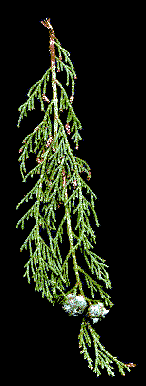|
|

C. atlantica.

C. funebris foliage.

C. macrocarpa.
Common Names
Cypress (1).Taxonomic notes
A genus of 12-24 speces, depending on taxonomic interpretation. The large range of opinion occurs because cypresses generally occur in small isolated populations distinguished by small differences, interpreted by some as valid at species rank, but by others only at varietal or subspecific rank. Recent trends (e.g. 1, 2, 3) have been toward the latter view; for a narrower species concept, see (4). Cone morphology of allied taxa (e.g. the C. arizonica group) varies as much or more within populations than between populations (M. P. Frankis, pers. obs.), supporting the broad species concept.Despite the relatively large genetic distance between Cupressus and Chamaecyparis (5, 6), delimitation of these two often superficially very similar genera has been subject to extensive dispute. C. funebris in particular has been moved back and forth repeatedly, with the most recent chemical and phenological evidence (3, 4) showing it to belong in Cupressus. Another species commonly placed in Chamaecyparis, Ch. nootkatensis, may soon also be returned to Cupressus (7, 8).
Perhaps surprisingly, the closest genetic relative of Cupressus is Juniperus, with Platycladus and Microbiota also close (5, 6).
Description
Trees or large shrubs, evergreen. Branchlets terete or quadrangular, in decussate arrays in most species; flattened (comblike), superficially resembling Chamaecyparis or Thuja in others. Leaves opposite decussate in 4 ranks, rarely in alternating whorls of 3 in 6 ranks. Adult leaves appressed to divergent, scalelike, rhomboid, free portion of long-shoot leaves to 4 mm; abaxial gland present or absent. Pollen cones with 4-10 pairs of sporophylls, each sporophyll with 3-10 pollen sacs. Seed cones maturing in (?1-)2 years, exact maturation period poorly researched, mostly varying from about 16-25 months after pollination; generally persisting closed many years or until opened by fire, but opening on maturity, and falling soon after seed release, in a few species; globose or oblong, 8-43 mm; scales persistent, (2)3-6(7) opposite decussate pairs, valvate, peltate, thick and woody, the terminal pair either fused or open with a small central columella (varying from cone to cone on a single tree). Seeds (3)5-20 per scale, lenticular or faceted, narrowly 2-winged; cotyledons 2-5. x = 11 (1, 9).Range
Warm north temperate regions (1): W USA, Mexico and adjoining Central America, NW Africa, Middle East and eastward along the Himalaya to SW & Central China and N Vietnam.Big Tree
I have no data for many species, but among the European and New World species, C. macrocarpa is clearly the largest. The largest individuals are all in cultivation.Oldest
Based on habitat (trees native to desert mountains tend to live a very long time), I suspect C. dupreziana (9), but there are very few age data on Cupressus in general.Dendrochronology
Several species have proven useful in climate reconstruction, archeological dating, and ecological studies. The genus appears to be less intractable that most of the Cupressaceae with regard to such problems as poor ring boundaries, false rings, and poor circuit uniformity. See the individual species for details.Ethnobotany
Several species are of horticultural importance; fastigiate forms of C. sempervirens, C. duclouxiana and C. funebris have been cultivated for ornament for several thousand years in the Mediterranean region and S China respectively, and the highly decorative weeping C. cashmeriana similarly long around the Buddhist Temples of Sikkim, Bhutan, Assam and nearby areas of Tibet and India.The wood is valued for its sweet scent and resistance to decay. Famous uses of the wood (of C. sempervirens) include Noah's Ark (10), and the doors to St. Peter's, Vatican City, Rome, which were still sound after 1,100 years' use (11).
Observations
Remarks
The genus name is from the Roman name for C. sempervirens, itself a loan word via Greek Kuparissos from Hebrew Gopher (2).Citations
(1) James E. Eckenwalder at the Flora of North America web site.(2) M.P. Frankis 1992. Cupressus. In: Griffiths et al. (eds) The New RHS Dictionary of Gardening 1: 781-783.
(3) Farjon 1998.
(4) Rushforth 1987.
(5) Gadek & Quinn 1993.
(6) S.J. Brunsfeld et al. 1994. Phylogenetic relationships among the genera of Taxodiaceae and Cupressaceae: Evidence from rbcL sequences. Syst. Bot. 19: 253-262.
(7) H.J. Welch 1991. The Conifer Manual vol. 1.
(8) M.P. Frankis 1993. Nootka Cypress: Chamaecyparis or Cupressus? Conif. Soc. Austral. Newsletter 12: 9-10.
(9) Contributions by M.P. Frankis based on personal experience, 3-Feb-1999.
(10) Anonymous. No date. The bible, Genesis 6: 14.
(11) Loudon, 1838, cited by (9).
See also:
Goggans, J.F. and C.E. Posey. 1968. Variation in seeds and ovulate cones of some species and varieties of Cupressus. Circ. Agric. Exp. Sta., Alabama 160:1-23.
This page co-edited with M.P. Frankis, Feb-1999.
Cupressus | Cupressaceae | home
This page is from the Gymnosperm Database
URL: http://www.geocities.com/RainForest/Canopy/2285/cu/cup/index.htm
Edited by Christopher J. Earle
E-mail:
earlecj@earthlink.com
Last modified on 2-Feb-2000